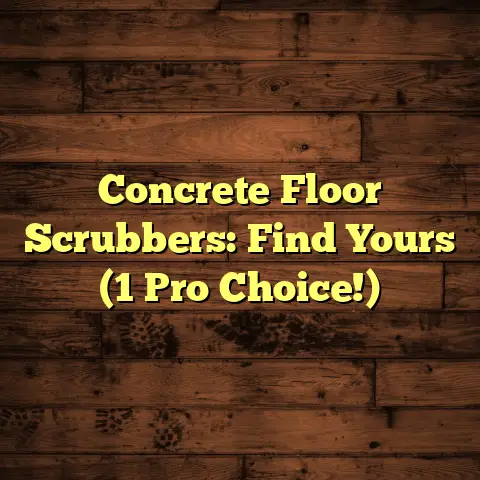How To Keep Slab Floors Warm? (2 Heat Loss Culprits!)
Slab floors are super popular,
and for good reason.
They’re tough,
easy to clean, and last forever.
But let’s be honest, they can feel like walking on ice, especially in the winter.
Have you ever stepped onto a cold
slab floor and instantly regretted it?
I know I have!
The good news is, it doesn’t have to be
that way.
We can fix this.
Today, I’m going to walk you through the two biggest reasons your slab floor might be freezing, and what you can do about it.
Think of this as a friendly chat about
making your home a warmer,
more inviting place.
Ready?
Let’s dive in!
Understanding Slab Floors
First things first, what exactly is a
slab floor?
Simply put, it’s a concrete
(or sometimes stone or tile) foundation
that also serves as the finished floor.
You see them a lot in modern homes
because they’re durable and look great.
Plus, they can handle a ton of weight.
But here’s the thing about concrete:
it’s thermally conductive.
That means it’s really good at
transferring heat.
Think of it like this:
if the ground underneath your slab is cold,
your floor is going to get cold, too.
It’s basic heat transfer.
Heat always moves from warmer areas to colder areas. This is conduction.
So, if your cozy, warm house is sitting on a cold slab, your heat is going to try to escape downwards into the ground.
This is why slab floors can feel so cold,
especially in basements or on the
ground floor.
But don’t worry,
we can tackle this!
Heat Loss Culprit #1 – Poor Insulation
Alright, let’s get to the first big
problem: insulation.
Or rather,
the lack of it.
Imagine your slab as a giant ice cube sitting directly on the earth.
Without insulation, there’s nothing stopping the cold from seeping up into your floor and sucking the heat out of your home.
Heat loss occurs through conduction when the slab is in direct contact with the cold ground.
That’s why proper insulation is key.
It creates a barrier between your slab
and the cold ground, preventing that
heat transfer.
So, what kind of insulation are we talking about? There are a few options:
Rigid Foam Boards: These are
probably the most common.
They’re
easy to install and provide great
insulation.
Think of XPS (extruded
polystyrene) or EPS (expanded
polystyrene) boards.-
Spray Foam: This stuff is great
for getting into hard-to-reach places
and creating a tight seal. -
Insulation Blankets: These are
like giant rolls of insulation that you
lay down before pouring the slab.
Now, how do you know if your
insulation is up to snuff?
Well,
if you’re building a new home,
make sure your contractor is using
enough insulation.
Building codes often specify minimum
insulation levels (R-value) for slab
floors.
In colder climates, you’ll want
a higher R-value.
If you’re in an existing home, it’s a
little trickier.
You might have to do
some detective work.
Here’s what I’d do:
Check the Edges: See if you can
spot any insulation around the perimeter
of the slab.
Sometimes it’s visible
in the basement or crawl space.Look for Cold Spots: On a cold day,
walk around your floor and feel for
cold spots.
This could indicate areas
where insulation is lacking.Energy Bill Analysis: Compare your
energy bills to similar homes in your
area.
If yours are significantly higher,
poor insulation could be to blame.
Retrofitting insulation in an existing
home can be challenging, but it’s
definitely doable.
It often involves
digging around the perimeter of the
foundation to install insulation boards.
It’s a bit of a project, but the payoff in terms of comfort and energy savings can be huge.
According to the U.S.
Department of
Energy, proper insulation can save
homeowners up to 15% on their
heating and cooling costs.
That’s not just pocket change; it’s a significant amount of money back in your wallet!
Heat Loss Culprit #2 – Air Gaps and Drafts
Okay, let’s move on to the second big culprit: air gaps and drafts.
Even if you have good insulation, air leaks can still sabotage your efforts to keep your slab floor warm.
Think of it like this:
you’re wearing a warm coat,
but it has holes in the pockets.
You’re still going to feel the cold!
Air leaks can happen for a number
of reasons.
Sometimes it’s due to
improper installation of flooring
materials.
Other times, it’s simply
deterioration over time.
Common sources of drafts around slab floors include:
Gaps between the slab and walls:
This is a big one.
Over time, the
slab can settle, creating gaps
between it and the walls.-
Around Windows and Doors: Even
if your windows and doors are
properly sealed, drafts can still
sneak in. -
Other Adjoining Structures: Any
place where the slab meets another
part of the house (like a fireplace
or a plumbing pipe) is a potential
source of air leaks.
So, how do you find these sneaky
drafts?
Here are a few methods I
recommend:
Visual Inspection: Start by simply
looking for gaps and cracks.
Pay
close attention to the areas I
mentioned above.Smoke Pencil Test: On a windy day,
hold a lit smoke pencil (you can buy
these online or at hardware stores)
near potential leak areas.
If the
smoke wavers or is sucked towards
a particular spot, you’ve found a draft.Infrared Thermometer: These handy
devices can detect temperature
differences.
Point it at your walls
and floors, and look for cold spots.
Once you’ve identified the air leaks,
it’s time to seal them up.
Here are
some solutions I’ve used:
-
Caulking: This is your go-to for
sealing small gaps and cracks.
Choose a high-quality caulk that’s
designed for use on concrete. -
Weather Stripping: Use weather
stripping around windows and doors
to create a tight seal. Foam Sealants: For larger gaps,
expanding foam sealants can be a
good option.
Just be careful not to
overfill, as they can expand quite a bit.
Let me tell you about a time when I helped a homeowner with this problem.
They had a beautiful slab floor in their living room, but it was always freezing.
After doing some detective work, I discovered a huge gap between the slab and the exterior wall.
We sealed it up with caulk and foam, and the difference was incredible.
The homeowner told me that they could finally walk around barefoot without their feet turning into ice cubes!
Sealing drafts might seem like a small thing, but it can have a huge impact on your comfort level.
Plus, it can save you money on your
energy bills.
The EPA estimates that
sealing air leaks can save homeowners
up to 20% on their heating and cooling
costs.
That’s a win-win!
Additional Methods to Keep Slab Floors Warm
Okay, so we’ve covered the two main culprits: poor insulation and air gaps.
But there are also some other things you can do to make your slab floor feel warmer.
While addressing those two culprits is the most important thing, let’s briefly touch on other methods.
Let’s consider a few options:
-
Area Rugs: This is probably the
easiest and most affordable option.
Rugs provide a layer of insulation
between your feet and the cold floor. Radiant Floor Heating: This is a
more expensive option, but it’s
incredibly effective.
Radiant floor
heating systems circulate warm water
or electricity under the floor,
warming it from the bottom up.-
Furniture Placement: Strategically
placing furniture can also help.
For example, placing a sofa or
bookshelf against an exterior wall
can help to block drafts and reduce
cold exposure.
Each of these methods has its own advantages and disadvantages.
Rugs are cheap and easy, but they don’t provide as much warmth as radiant floor heating.
Radiant floor heating is amazing, but it’s a significant investment.
The best approach is often to combine these methods with the solutions we discussed earlier.
For example, you could seal air leaks, add insulation, and then throw down some rugs for extra warmth.
Conclusion
Alright, we’ve covered a lot of ground today. Let’s recap the key takeaways.
Slab floors are durable and beautiful, but they can be cold.
The two biggest reasons for this are poor insulation and air gaps.
By addressing these two issues, you can significantly improve the warmth and comfort of your home.
Remember, proper insulation creates a barrier between your slab and the cold ground, preventing heat transfer.
Sealing air leaks prevents drafts from sucking the heat out of your home.
And while you’re at it, consider adding some rugs or investing in radiant floor heating for extra warmth.
Properly maintained slab floors are
incredibly long-lasting and durable.
Adding warmth just enhances their
livability and makes your home a
more enjoyable place to be.
So, what are you waiting for?
Take
action!
Assess your own home and
see if you can identify any areas
where insulation or air sealing could
be improved.
You might be surprised at how much of a difference it makes.
Trust me, your feet (and your wallet) will thank you!





